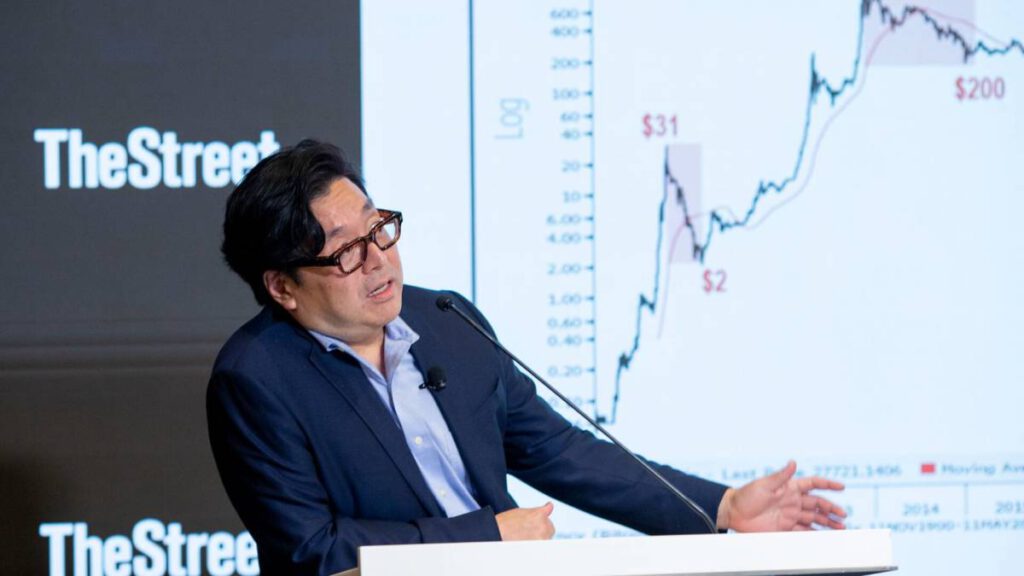Wall Street is flooded with bullish forecasts, but Tom Lee’s latest one is making heads turn. The Fundstrat co-founder says the S&P 500 could run up to a record 7,000 by year-end, but only if two telling signals break his way.
It’s far from guesswork, as Lee frames the back-end of 2025 as critical, with a clear roadmap to either go big or go home.
The call’s especially bold when pitted against the inflation jitters and Fed uncertainty still looming.
💵💰Don’t miss the move: Subscribe to TheStreet’s free daily newsletter💰💵
What he’s watching is likely to surprise even the seasoned pros and will likely shape how markets finish the year.
Image source: Abby Nicolas
Who is Tom Lee?
Tom Lee is one of the most respected Wall Street strategists known for not playing it safe.
As co-founder and research head at Fundstrat Global Advisors, Lee is known for his blunt, data-backed calls on the stock market, which typically cut against the grain.
Before launching Fundstrat over a decade ago in 2014, he spent years as J.P. Morgan’s Chief U.S. Equity Strategist, building frameworks based on key macro trends, liquidity flows, and earnings revisions.
Related: Figma’s IPO stunned Wall Street, now a quiet $42B move hints what’s next
Perhaps his most standout calls include his outspoken stance during the 2020–21 post-pandemic rally, where he made some pertinent arguments that falling real yields would result in an upward revision in equities.
What sets Lee apart is his transparency. He clearly lays out and defines his triggers, revises when the facts on the ground evolve, and supports views with a variety of data.
Add in his regular CNBC appearances and closely followed research notes, and his outlooks reliably shape the stock market conversation.
Tom Lee’s 7,000 S&P 500 target: What needs to happen
Fundstrat’s Tom Lee just laid out a bold new bull case for the S&P 500, predicting it could hit 7,000 by year-end, if two key things fall into place.
First, there’s the obvious: he feels the Federal Reserve needs to start cutting interest rates.
Second, U.S. manufacturing activity needs to pick up again and quickly. That’s usually tracked by the ISM Manufacturing Index, where a 50+ reading signals healthy growth. The problem is that it has been stuck below that level for over two years.
“The Fed will finally cut rates… [and] the ISM will finally recover >50, after spending 28-months plus below 50,” said Lee.
Lee sees 2025 in three parts.
Related: Moody’s chief who nailed 2007 housing bust revives recession fears
- The first started rocky with tariff fears,
- Followed by a V-shaped rally from April (a sharp drop and quick rebound), and
- A pathway toward clearer and more accommodating Fed policy and stronger economic momentum to finish the year.
Analyst base case S&P 500 forecast remains 6,600
His base case is still at 6,600, though, but he feels 7,000 is possible if the Fed cuts and ISM turns positive.
Lee argues this is a classic late-cycle setup where interest rate cuts lower real yields, helping stock valuations, while an improved ISM reading supports bottom-line expansion.
More News:
- Billionaire George Soros supercharges Nvidia stake, loads up on AI plays
- Tesla just got its biggest break yet in the robotaxi wars with a key permit
- Bank of America drops shocking price target on hot weight-loss stock post-earnings
But there’s risk. If tariffs result in more inflationary pressures or ISM stays weak, 6,600 might be as good as it gets.
The S&P 500’s returns so far in 2025
Here’s where things are with the three top stock market indices as of Wednesday, August 20, 2025:
- S&P 500-6,395.78 (YTD gain: 8.7%)
- Nasdaq– 21,172.86, (YTD gain: 9.6%)
- Dow-44,938.31, (YTD gain: 5.6%)
2025’s S&P story has been mostly a classic tug-of-war, where AI leadership met with valuation fatigue. Then you had rate-cut hopes pitted against tariff-driven inflation risk, which has left the index modestly higher YTD.
Related: Top tech stock analyst revamps AI ‘buy’ list
Zooming in on things in particular, here’s a breakdown of the S&P 500’s quarterly performance:
Jan–Mar (Q1 through Mar 31)
- Performance: –4.6% (–269.78 pts) to 5,611.85.
- What drove it: Sticky inflation readings and faltering hopes of interest rate cuts, along with elevated tariff jitters. Not to mention, Big Tech wobbled in the process, along with AI bubble concerns with China’s DeepSeek release.
Apr–Jun (Q2 through Jun 30)
- Performance: +10.57% (+593 pts) to 6,204.95, turning out as the best quarter in more than a year, finishing at record highs.
- What drove it: Optimism over trade deals rose, and rate cut odds improved, with June alone adding 5% with momentum broadening into cyclicals.
Jul–Mid Aug (through Aug 20)
- Performance (updated to Aug 20): +3.08% (+190.83 pts) from 6,204.95 (6/30) to 6,395.78 (8/20).
- What drove it: Improving odds of a September cut compared to the tariff overhang.




